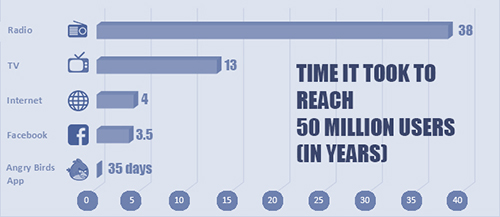Marketing B2B
Technology Adoption Rates: How Marketing Contributes?

- Published: 18/09/2014
- (Revised: 02/02/2023)
- Reading time: 2 minutes
Picture the world ten years ago. How different was the technology we used then compared to what we use now? The Internet was just starting to become commonplace and smartphones and social media were barely in existence! It is difficult to imagine living in a world like that today. Yet, if you had imagined the same thing a hundred years ago, a ten-year difference meant hardly any change in lifestyle. It is clear that today’s technology adoption rates are rapidly increasing and will continue to do so for the foreseeable future. So, how come so many technology companies fail while overall technology adoption rates are accelerating? What is the differentiating factor that makes some successful and others a total failure? The answer is simple: marketing. How can marketing be used to accelerate new product adoption when technology adoption rates are increasing at unprecedented speed?

Fortunately, we have the answer to this question thanks to a concept conceived at the mid-20th century that still applies today. This concept is Everett Rogers’ Diffusion of Innovations Theory which seeks to explain the process behind new concepts and technologies and their spread through cultures. The theory states that there are four main elements that influence the new product adoption rate:
- Innovation: an idea, practice, or object that is perceived as new by an individual
- Communication channels: the means by which messages are transferred from one individual to another
- Time: the time from which the innovation is first known until it is either accepted or rejected by a potential user
- Social system: a set of interrelated units that are engaged in joint problem solving to accomplish a common goal (an institution, a neighborhood, a nation)
Being aware of these four elements, we can now see how they can relate to technology adoption rates and discuss ways in which we can improve them. Let’s examine each element and how technology companies can use marketing to reduce the amount of time it takes for their product to be accepted and adopted by their clients.
Innovation: What does your product bring to the table that isn’t already there? In order for your innovation to create a buzz, it must present something worth talking about. This is where a good positioning strategy can make all the difference. Your product must be perceived as new and special, whether it is a breakthrough innovation or not.
Communication channels: As a tech company, you must be able to identify the channels that your target market listens to. What blogs do they visit? Are they a member of a certain social media group? Do they go to a particular professional meeting or conference? You must learn how to use these and other channels to effectively highlight your solution if you hope to increase your technology’s adoption rate.
Time: Thanks in large part to the Internet, modern communication channels have allowed for faster communication than ever before. To boost your new product’s adoption rate, your marketing strategy and execution must communicate your product’s value as clearly and concisely as possible or risk being rejected by potential clients who are already accustomed to instantaneous communication. Time is money. If clients don’t understand your product within five seconds, they will move on and not look back.
Social system: Today, a social system encompasses more than just physical examples such as neighborhoods, offices, or schools. Increasingly, there is emphasis placed upon online social systems such as review sites, forums, wikis, video/photo sharing sites, social networks, and other digital communities. These are very powerful tools that can quickly and easily spread messages in a timely manner. You must choose your target market appropriately and decide how to incorporate these online communities into your customer acquisition strategy in a way that still allows for the potential use of more traditional social systems.
The bottom line is that for a successful adoption rate of your new technology, you must invest in marketing that addresses all four of these factors. Technology is changing our world and evolving at an ever-increasing pace. To be a winner, you must find a way to keep ahead of this pace.

What's Your MarketingReadyTM Ranking?
Contact Direct Objective Consulting to discuss your marketing challenges and learn how to take advantage of the Diffusion of Innovations Theory and use its insights to boost your solution’s technology adoption rate.
Testimonials
“Ranking our Web site high on search engines results, designing a professional Web site look and developing engaging relevant content for a heavy technology company like us resulted in a dramatic increase in client leads that we receive from our Web site.”
Simon Robin CEO, Hardent


